Multiple Choice
Identify the
choice that best completes the statement or answers the question.
|
|
|
The emergence of the People's
Republic of China signals a new and dangerous phase in the Cold War. But later on (through the
efforts of Richard Nixon), a split between Moscow and Beijing opens the door for a change in
U.S.-Chinese relations.
A NEW
CHINA
For many years the United States and China had been allies. Americans felt a special
bond to the Chinese people. It was because of Japan’s invasion of Chinese Manchuria that the
U.S. placed an embargo on Japan, leading to the attack on Pearl Harbor. In dismay, America watched
its former ally become its enemy.
In 1949, the People's Liberation Army arrived in Beijing --
celebrating a communist victory and the end of their decades-long civil war against the Nationalists.
Led by Mao Tse-tung, the communists establish the People's Republic of China. The U.S.
government, which had considered China among its allies in Asia, is devastated by the
"loss" of China to the communists. | 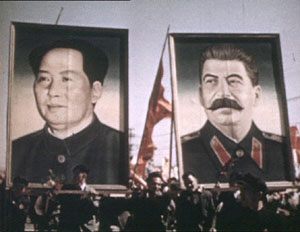
Mao and Stalin
Exhausted by the long war, Mao needed external
help for China's reconstruction. One of his first acts is to visit Moscow, seeking military
protection and economic aid. Mao wanted to conclude a Chinese-Soviet friendship treaty with Stalin --
but the two leaders remained wary of each other. After several months of negotiation, the Chinese and
the Soviets signed a mutual defense treaty -- which also guaranteed aid for China. For Stalin it was
proof that communism was the wave of the future. The largest nation in the world was now
communist. | | |
|
|
|
1.
|
What is the largest communist
nation in the world?
a. | China | c. | Soviet Union | b. | Russia | d. | Eastern Europe (including East
Germany) |
|
|
|
2.
|
Who were the communists
fighting in the civil war in China?
a. | The
Socialists | c. | The
nationalists | b. | The Capitalists | d. | The democrats |
|
|
|
3.
|
What did Mao need from
Stalin?
a. | military
protection | c. | military
protection and economic aid | b. | economic aid | d. | military aid and economic
protection |
|
|
|
4.
|
Why did the U.S. place an
embargo on Japan in the 1930’s
a. | Japan invaded Chinese
Manchuria | c. | Japan was selling
too many cars in the U.S. | b. | Japan invaded Korea | d. | Japan was trying to control the TV
business. |
|
|
|
REFORM/WAR
China's new rulers embarked on radical land reforms.
Land was taken from private owners and handed to the peasants. Former landowners were denounced and
humiliated. One million people lost their lives. Later the land was taken from the peasants and
turned over to the communist government.
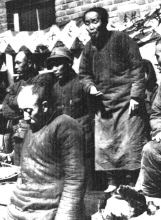
Former land owners put on
trial
| 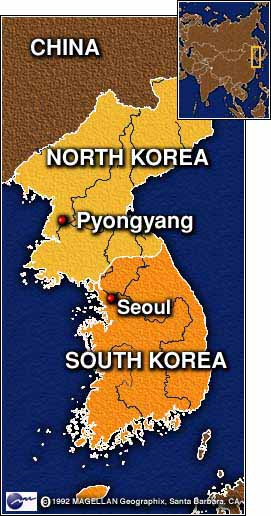 | | |
|
|
|
5.
|
After the communists took over
in China, land was taken from the former owners and given to the peasants. This was called
a. | commune
farming | c. | land
reform | b. | proletariat farming | d. | peasant power |
|
|
|
6.
|
Who, eventually, controlled all
of the land in China?
a. | The former
owners | c. | The
capitalists | b. | The peasants | d. | The government |
|
|
|
7.
|
Which countries supported North
Korea’s attack on South Korea?
a. | The
Soviets | c. | The Soviets and
the Chinese | b. | The Chinese | d. | The Soviets, Chinese and
Vietcong |
|
|
|
8.
|
Why did China attack the U.N
forces in Korea
a. | They did not like the
U.N. | c. | They wanted to use Korea as a
staging area to attack Japan | b. | They wanted to make sure North Korea stayed
communist | d. | They wanted a unified
Korea |
|
|
|
9.
|
China shares a border with
a. | South
Korea | c. | The United
Nations | b. | North Korea | d. | Japan |
|
|
|
TENSIONS
Stalin's death in 1953 had a deep impact in China.
Despite Mao's misgivings, he had long respected Stalin's iron authority. Nikita Khrushchev
soon emerged from the Kremlin power struggle as the new Soviet leader and Mao was not sure he was a
powerful leader.. Khrushchev and his Politburo visited China to maintain the Beijing-Moscow alliance
-- a move that made the new Eisenhower administration in Washington increasingly anxious. As part of
its policy to contain communism, the United States financed a military buildup on Taiwan -- home for
the Chinese Nationalists.
But Mao
did not give way to the American show of strength. His forces shelled the Nationalist-held islands of
Quemoy and Matsu in the Taiwan Straits. | 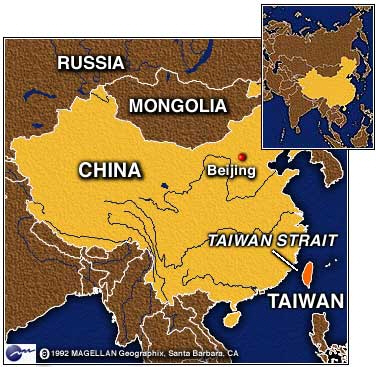 The U.S. sent its fleet to
patrol the Taiwan Straits and also to send a message to Communist China that it had better not invade
Taiwan. Mr. Schneemann was in the Taiwan straits during the shelling so China backed off. The U.S. sent its fleet to
patrol the Taiwan Straits and also to send a message to Communist China that it had better not invade
Taiwan. Mr. Schneemann was in the Taiwan straits during the shelling so China backed off.
The
rising U.S.-Chinese tensions concerned Khrushchev -- who told Beijing that war with imperialism was
no longer inevitable. | | |
|
|
|
10.
|
What is the capital of the
Soviet Union
a. | Beijing | c. | Stalingrad | b. | Moscow | d. | Taipei |
|
|
|
11.
|
What is the capital of
China?
a. | Beijing | c. | Moscow | b. | Taiwan | d. | Kaoshung |
|
|
|
12.
|
A body of water between two
land masses is called
a. | an
island | c. | a
straight | b. | an inland sea | d. | a gulf |
|
|
|
13.
|
What was the Beijing-Moscow alliance?
a. | An alliance between Taiwan and
Moscow | c. | An alliance between China and
Russia | b. | An alliance between China and Taiwan | d. | An alliance between the Soviets and
Asia |
|
|
|
14.
|
Who were the Chinese
Nationalists?
a. | They fought against the communists
in the China civil war | c. | They were the
Chinese communists | b. | They fought against China in the Korean war. | d. | They were allies of the Soviet Union and that is why Mao was nervous about
them. |
|
|
|
15.
|
Taiwan used to be called
Formosa. Who controlled Taiwan in the 50’s and still does today?
a. | The Chinese
Communists | c. | The North
Koreans | b. | The Chinese Nationalists | d. | The U.S. and Japan |
|
|
|
16.
|
Who was president of the U.S.
when Stalin died in 1953?
a. | Kennedy | c. | Eisenhower | b. | Truman | d. | Nixon |
|
|
|
SPLIT
Khrushchev's attempts to steer the U.S.S.R. away from its Stalinist past
-- and his denunciation of Stalin as a criminal -- alarmed Mao, who took such actions as a threat to
his own style of leadership. China, meanwhile, was chafing over Soviet attempts to control the
Beijing government. In the late 1950s, Khrushchev visited China at least twice to renew Soviet
support.
China and the Soviet Union share a very long border. China had long considered parts of
Russian Siberia to be part of China. Both China and Russia had large numbers of troops stationed on
their borders and there were minor conflicts from time to time.
But China's relations were
already strained with its declared "big brother," and the Soviet leader could find no
common ground with Chinese officials. Khrushchev, who had recently visited the United States, was
accused by the Chinese of being an American stooge. Soon afterward, Soviet advisers were withdrawn
from China. The struggle for pre-eminence in the communist world was now out in the open.
| | | |
|
|
|
17.
|
Soon after coming to power,
Khrushchev made a speech called, “Crimes of the Stalin Era,” in which he condemned Stalin
for his brutal policies. Why would this alarm Mao Tsi Tung, the leader of China.
a. | Mao was a friend of
Stalin | c. | Mao wanted China to become part of
Russia | b. | Mao helped Stalin with his purges in Russia | d. | Mao behaved similar to Stalin and thought Khrushchev might come after him
next |
|
|
|
18.
|
How did Mao feel about Soviet
attempts to control his nation?
a. | He resented
it | c. | He welcomed it because he believed
that the Russians were smarter than the Chinese | b. | He welcomed it because China had many problems that Mao
could not solve | d. | He ignored
it |
|
|
|
19.
|
Why did Mao call Khrushchev a
“U.S. stooge?”
a. | Khrushchev visited the U.S.
| c. | Khrushchev became a
capitalist | b. | Khrushchev took down the Berlin wall at America’s
request | d. | Khrushchev gave up his idea of Soviet domination of
Eastern Europe |
|
|
|
20.
|
Even though there were problems
between the Soviets and China, they were still communist and united in there desire to make the
entire world communist.
|
|
|
|
|
|
21.
|
Mao’s, “Great Leap
Forward” can be characterized as
a. | a small
failure | c. | a disaster for
China | b. | a break even policy for China | d. | a moderate success |
|
|
|
22.
|
When the leadership of the Mao
government was threatened, how did they react?
a. | they called out the Chinese military
to suppress revolt against the Mao government | c. | They looked for ways to reform the culture and make it more open and
democratic. | b. | they mobilized the young people into a cultural revolution that persecuted
everyone who did not support Mao | d. | They turned away from the Soviets and toward
capitalism. |
|
|
|
23.
|
Who were the Red
Guards”
a. | young people who supported
Mao | c. | military people who were against
Mao | b. | intellectuals and scientists who supported
Mao | d. | young people who condemned
Mao |
|
|
|
PINGPONG
DIPLOMACY
Mao, fearful of
Moscow's belligerence, decided he wanted better relations with the United States. The new U.S.
President, Richard Nixon, was a lifelong anti-communist. But Nixon, wanting to limit Soviet power and
end the Vietnam War, drew closer to China. The first sign of a thaw in U.S.-Chinese relations came in
1971 -- when a U.S. table tennis team, playing in Japan, was suddenly invited to China.
For years
there had been no contact between China and the U.S. To most Americans, China was a mysterious
communist nation that we had to fear. When China invited the U.S. ping pong team to compete in China
most Americans welcomed the thaw in relations.
The so-called "pingpong diplomacy" led
to more breakthroughs -- culminating with Nixon's historic trip to China in February 1972. The
visit was mostly symbolic -- formal diplomatic relations were not restored until 1979 -- but it
helped reduce tensions between the two nations and brought new pressure on a shared rival: the Soviet
Union.
The Soviet Union was now afraid that China might align itself with the U.S. against
Russia. Because Nixon had been such a strong anti-communist, people trusted him and believed that
communist China could not take advantage of him. Most historians agree that Nixon was a genius in
foreign affairs and his visit to China was the beginning of the end of the cold
war.
|

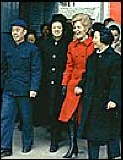

Pingpong Diplomacy Resulted in Nixon’s Visits
to China | | |
|
|
|
24.
|
There is a famous saying,
“Only Nixon Could Go To China.” What does that ;phrase mean.
a. | The Chinese did not trust
Democrats | c. | Since Nixon had
the reputation of being an anti-communist, the American people trusted him to deal with
China. | b. | Nixon was not very bright so the Chinese communists trusted
him | d. | Nixon was president when the ping pong team was invited to
China |
|
|
|
25.
|
Nixon and his National Security
Advisor, Henry Kissinger, caused the split between the Soviets and China to grow wider. This split
had the effect of drawing China and the Soviets closer to the United States. After 1972 China looked
to the U.S. as _____ Russia.
a. | an enemy of
Russia | c. | an allie
of | b. | a balance
against | d. | the leader of
|
|
Problem
|
|
|
26.
|
Explain how President
Nixon’s trip to China effected the U.S., China and the Soviet Union.

|